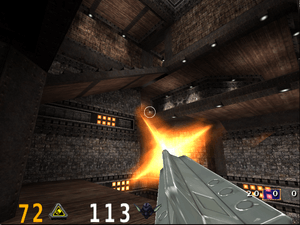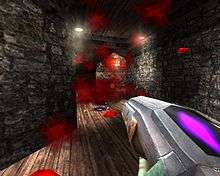OpenArena
 | |
 screenshot from version 0.6.0 (2006) | |
| Developer(s) | Free software community |
|---|---|
| Initial release | 2005 |
| Stable release |
0.8.8
/ February 2012 |
| Repository |
|
| Written in | C with the ioquake3 game engine |
| Platform | Unix-like, MS Windows, macOS, Android, iOS, Ouya, Pandora, BlackBerry 10, AmigaOS 4 |
| Type | Single-player, multiplayer First-person shooter |
| License | GPLv2 |
| Website |
openarena |
OpenArena is a free and open-source video game. It is a first-person shooter (FPS), and a video game clone of Quake III Arena.
Development
The OpenArena project was established on August 19, 2005, one day after the id Tech 3 source code released under GNU GPL license.
Its official website includes downloads for Microsoft Windows, Linux, and macOS operating systems. Thanks to third-party efforts, it is also available from the default repositories of a number of open-source operating systems, including Debian, Fedora, FreeBSD,[1] OpenBSD, Gentoo, Mandriva, Arch and Ubuntu. It is also in development for the Maemo mobile operating system. Ports for Raspberry Pi,[2] Android[3] and iOS[4] are available, too.
An assets "reboot" named "OA3" is planned, with the aim of steering the art style away from the classic space and gothic themes to "something more manga inspired", while also raising its quality and performances standards.[5]
Gameplay


OpenArena's gameplay attempts to follow Quake III Arena: score frags to win the game using a balanced set of weapons each designed for different situations, with just minor changes to the rules enabled by default (like awarding a character for pushing another one to their death).
Each match happens in an "arena": a map where players try to kill each other; some arenas are designed for Capture the flag and similar gametypes, so are built with two bases (usually identical, apart from the colors), for the two teams.
The Quake III style of play is very fast and requires skill to be played successfully online. It's an arcade-style gameplay which allows players to quickly move through maps thanks to bouncepads, accelerator pads, teleporters and advanced techniques such as strafe jumping and rocket jumping. Some arenas include traps.
The game can be played online (against other human players) or offline (against computer-controlled characters known as bots). "Singleplayer" mode allows players to play a pre-defined series of deatchmatches, unlocking a new "tier" of four maps after completing the previous one, or to create custom matches in any gametype through the "skirmish" mode.
Game modes
As of OpenArena 0.8.8, maps can be played in at least one of these gametypes: Deathmatch (called as Free For All in the game), Team Deathmatch, Tournament, Capture The Flag, One Flag CTF, Harvester, Overload, Elimination, CTF Elimination, Last Man Standing, Double Domination and Domination:
- "Free For All" is classic Deathmatch, where players are all pitted against each other, and wins the player with the highest score at the end of the match, or the one with the highest number of frags when the time limit is reached.
- "Team Deathmatch" is a team-based variation of Deathmatch, with two teams of players being pitted against the other.
- "Tournament" chooses two players and makes them duel, in a classic "winner stays, loser gets out" setting.
- "Capture The Flag" is a team-based mode where each team spawns in a base which contains a flag. They must capture the enemy team's flag while keeping their own flag from being captured.
- "One Flag CTF" is a variation of Capture The Flag where a white flag spawns in the middle of the map, and the teams must bring it to the enemy base, instead of taking the enemy's flag.
- "Harvester" is another team-based mode played in some Capture The Flag scenarios. Each team spawns with a Skull Receptacle, and there's a Skull Generator at the middle of the map. By fragging enemies, skulls appear in this generator. The players must collect their enemies' skulls and bring them to the enemy base in order to score.
- "Overload" has both teams' bases spawn a crystal. The players of each team must travel to the enemy base and destroy this crystal in order to win.
- "Elimination" is a team based mode where both players must frag all of their enemies in a "Last Man Standing" match of sorts. The team with the highest number of points win the match.
- "CTF Elimination", as its name implies, is a mix of Capture The Flag and Elimination. Not only do the teams score by fragging all of the enemy team's players, but they also can win rounds by capturing their flags.
- "Last Man Standing" is a non-team variation of Elimination where all of the players start with a finite number of lives and frag each other until only one of them remains.
- "Double Domination" is a team-based game which features two control points, and the players must hold them during some seconds in order to score points.
- "Domination" is also team-based, and has control points scattered throughout the maps; the players must secure these points in order to rack up points for their teams.
Reception and impact
The game is one of the most popular open-source first-person shooters, particularly among fans of the original Quake III. It has only really been negatively criticized as somewhat incomplete as of yet, with some saying that this detracts from long term play.[6][7] OpenArena has also been praised for its portability and ability to run on old hardware.[8] Internet play has also been praised, as well as the number of players found on the average OpenArena server.[9] The game has also been credited for its creativity in bot design, rather than sticking to more traditional tropes.[10] OpenArena is also available on macOS, with one reviewer praising it as one of the best free games for the Mac, noting that it is only slightly behind contemporary commercially funded games for the PC and consoles in terms of graphics and artificial intelligence.[11]
OpenArena has been used as a platform for scholarly work in computer science. Some examples include streaming graphics from a central server,[12] and visualizing large amounts of network data.[13]
See also
References
- ↑ OperaArena FreeBSD Port on FreshPorts.org
- ↑ "OpenArena on Raspberry Pi store". Archived from the original on 2015-11-17. Retrieved 2013-08-20.
- ↑ OpenArena on Google Play Store
- ↑ Beben III on iTunes Store
- ↑ OpenArena 3 page on the official OpenArena Wiki
- ↑ OS Reviews - Pleasure to Frag
- ↑ Raiden's Realm - OpenArena Review
- ↑ "HeadShotGamer.com - OpenArena Review". Archived from the original on 2016-08-25. Retrieved 2016-08-11.
- ↑ Snappy Gamer - OpenArena: Open Source Quake III Fun
- ↑ Raiden's Realm - OpenArena Review
- ↑ MacApper - OpenArena: Pure Fragiliciouss Fun For Mac
- ↑ Peter Eisert and Philipp Fechteler (2007). "Remote rendering of computer games. Proceedings of the International Conference on Signal Processing and Multimedia Applications (SIGMAP), Barcelona, Spain, July 2007".
- ↑ Lucas Parry (2007). "L3DGEWorld 2.1 Input & Output Specifications. CAIA Technical Report 070808A, August 2007".
External links
| Wikimedia Commons has media related to OpenArena. |